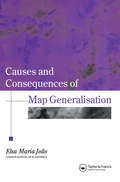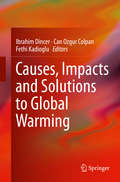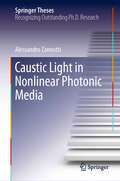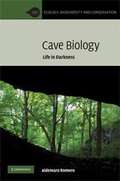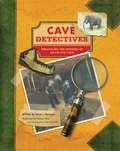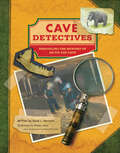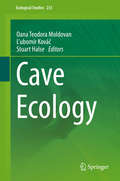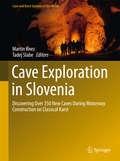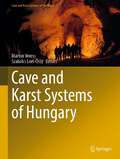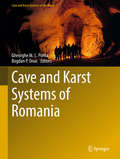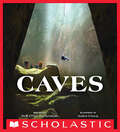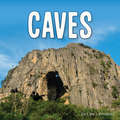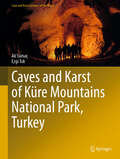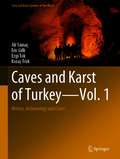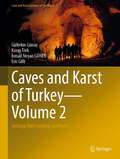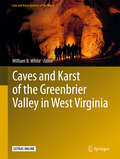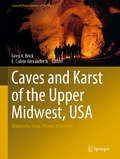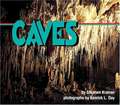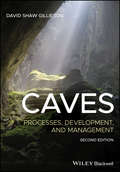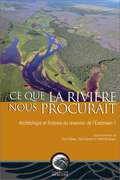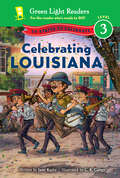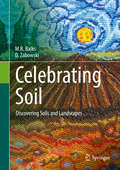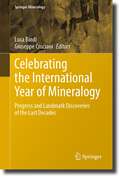- Table View
- List View
Causes And Consequences Of Map Generalization
by Elsa JoaoThis text describes late-1990s understanding of map generalisation in the context of paper maps and GIS. Its particular value should be in helping to further automate and measure the process of map generalisation.; The research has concentrated on quantifying generalisation effects and on analysing how these effects of generalisation locked into the maps were measured. Elsa Joao's book covers the background to the problems of map generlasation; the methodology developed by the author to investigate the consequences of the map generalisation; a detailed description of results, and a conclusion that draws together consequences for the broader applications to GIS.
Causes, Impacts and Solutions to Global Warming
by Ibrahim Dincer Can Ozgur Colpan Fethi KadiogluGlobal Warming: Causes, Impacts and Solutions covers all aspects of global warming including its causes, impacts, and engineering solutions. Energy and environment policies and strategies are scientifically discussed to expose the best ways to reduce global warming effects and protect the environment and energy sources affected by human activities. The importance of green energy consumption on the reduction of global warming, energy saving and energy security are also discussed. This book also focuses on energy management and conservation strategies for better utilization of energy sources and technologies in buildings and industry as well as ways of improving energy efficiency at the end use, and introduces basic methods for designing and sizing cost-effective systems and determining whether it is economically efficient to invest in specific energy efficiency or renewable energy projects, and describes energy audit producers commonly used to improve the energy efficiency of residential and commercial buildings as well as industrial facilities. These features and more provide the tools necessary to reduce global warming and to improve energy management leading to higher energy efficiencies. In order to reduce the negative effects of global warming due to excessive use of fossil fuel technologies, the following alternative technologies are introduced from the engineering perspective: fuel cells, solar power generation technologies, energy recovery technologies, hydrogen energy technologies, wind energy technologies, geothermal energy technologies, and biomass energy technologies. These technologies are presented in detail and modeling studies including case studies can also be found in this book.
Caustic Light in Nonlinear Photonic Media (Springer Theses)
by Alessandro ZannottiCaustics are natural phenomena, forming light patterns in rainbows or through drinking glasses, and creating light networks at the bottom of swimming pools. Only in recent years have scientists started to artificially create simple caustics with laser light. However, these realizations have already contributed to progress in advanced imaging, lithography, and micro-manipulation. In this book, Alessandro Zannotti pioneers caustics in many ways, establishing the field of artificial caustic optics. He employs caustic design to customize high-intensity laser light. This is of great relevance for laser-based machining, sensing, microscopy, and secure communication. The author also solves a long standing problem concerning the origin of rogue waves which appear naturally in the sea and can have disastrous consequences. By means of a far-reaching optical analogy, he identifies scattering of caustics in random media as the origin of rogue waves, and shows how nonlinear light-matter interaction increases their probability.
Cave Biology: Life in Darkness
by Aldemaro Romero Danté FenolioBiospeleology, the study of organisms that live in caves, has a tremendous potential to inform many aspects of modern biology; yet this area of knowledge remains largely anchored in neo-Lamarckian views of the natural world in both its approaches and jargon. Written for graduate students and academic researchers, this book provides a critical examination of current knowledge and ideas on cave biology, with emphasis on evolution, ecology, and conservation. Aldemaro Romero provides a historical analysis of ideas that have influenced biospeleology, discusses evolutionary phenomena in caves, from cave colonization to phenotypic and genotypic changes, and integrates concepts and knowledge from diverse biological viewpoints. He challenges the conventional wisdom regarding the biology of caves, and highlights urgent questions that should be addressed in order to get a better and more complete understanding of caves as ecosystems.
Cave Detectives: Unraveling the Mystery of an Ice Age Cave
by David L. HarrisonWhat was life like millions of years ago? The answer lies deep underground, in a place once home to a ferocious predator much larger than most animals walking around today. Through photographs and detailed illustrations, readers will learn how the secrets buried in a midwestern hillside helped scientists understand early life on Earth. This book's simple but informative format allows readers to follow along as paleontologist Matt Forir and his team of experts unravel a prehistoric mystery. Plus, this is the fixed-format version, which looks nearly identical to the print edition.
Cave Detectives: Unraveling the Mystery of an Ice Age Cave
by David L. Harrison&“Vivid descriptions of the animals, the cave, and the scientists are complemented by the original art and photos that work together unusually well.&” —Booklist What was life like millions of years ago? The answer lies deep underground, in a place once home to a ferocious predator much larger than most animals walking around today. Through photographs and detailed illustrations, readers will learn how the secrets buried in a midwestern hillside helped scientists understand early life on Earth. This book&’s simple but informative format allows readers to follow along as paleontologist Matt Forir and his team of experts unravel a prehistoric mystery. &“[An] account of the discovery and early exploration of Missouri&’s Riverbluff Cave, the oldest found so far in this country with fossil remains . . . may excite curiosity about the Riverbluff finds.&” —Kirkus Reviews
Cave Ecology (Ecological Studies #235)
by Oana Teodora Moldovan Ľubomír Kováč Stuart HalseCave organisms are the ‘monsters’ of the underground world and studying them invariably raises interesting questions about the ways evolution has equipped them to survive in permanent darkness and low-energy environments. Undertaking ecological studies in caves and other subterranean habitats is not only challenging because they are difficult to access, but also because the domain is so different from what we know from the surface, with no plants at the base of food chains and with a nearly constant microclimate year-round. The research presented here answers key questions such as how a constant environment can produce the enormous biodiversity seen below ground, what adaptations and peculiarities allow subterranean organisms to thrive, and how they are affected by the constraints of their environment. This book is divided into six main parts, which address: the habitats of cave animals; their complex diversity; the environmental factors that support that diversity; individual case studies of cave ecosystems; and of the conservation challenges they face; all of which culminate in proposals for future research directions. Given its breadth of coverage, it offers an essential reference guide for graduate students and established researchers alike.
Cave Exploration in Slovenia: Discovering Over 350 New Caves During Motorway Construction on Classical Karst (Cave and Karst Systems of the World)
by Martin Knez Tadej SlabeThis book focuses on the opening and exploration of more than 350 previously undiscovered caves of the Slovenian Karst, discovered during motorway construction work. The summarizes the planning of traffic roads and presents the new findings obtained during construction, as well as studies on newly-discovered karst phenomena and karst waters and their protection. Earthmoving work during construction has revealed a cross-section of the surface of the Classical Karst, covered karst with famous underground stone forests and unique karst in breccia. Research conducted in these caves has yielded a number of new findings on how the karst surface and underground were formed, on the flow of water through karst aquifers, and on the evolution of karst on various types of rock and under various conditions. The work was written by researchers from the ZRC SAZU Karst Research Institute and the Institute of Geology AS CR. The reader will benefit from the authors' collaboration with planners and builders, which offers valuable insights for the planning and execution of their own activities in karst regions.
Cave and Karst Systems of Hungary (Cave and Karst Systems of the World)
by Márton Veress Szabolcs Leél-ŐssyThis book describes Hungarian karst areas and Hungarian karst research results. The chapters present the general characteristics of karst areas, their geology, their paleokarst, their hydrology, their surface and subsurface morphology (more significant caves are classified according to karst areas and their morphology and development is described), ecology and flora and fauna.This book also includes a separate chapter which deals with the history of Hungarian karst and cave research. Another chapter deals with theories that were made during Hungarian karst researches.
Cave and Karst Systems of Romania (Cave and Karst Systems of the World)
by Gheorghe M. Ponta Bogdan P. OnacThis book focuses on Romania’s more than 12,000 caves, which developed in limestone (including thermal water caves), salt, gypsum, and occasionally in sandstone. It examines these caves and related topics in a format suitable for cavers, while also addressing a broad range of aspects useful for students and researchers. Since the Institute of Speleology was first established by Emil Racovita in 1920, a great deal of research has been conducted on all cave and karst types. As such, the book examines a variety of scientific fields, including karst geology, hydrogeology, biospeleology, paleoclimatology, mineralogy and archaeology.
Caves
by Nell Cross BeckermanA masterful exploration of one of nature's most curious ecosystems, Caves is a magical journey into subterranean wonders perfect for fans of Jason Chin.In the shade of the woods is a hill with a hole. Beaconing black. Goosebump chills. Excitement and fear battle. What will win? You want to go in...do you dare?Using evocative storytelling, Nell Cross Beckerman urges children to explore one of nature's most curious ecosystems. Dramatic, poetic language guides kids through different caves around the world while nonfiction text allows for deeper understanding.Debut illustrator Kalen Chock's stunning illustrations will astonish readers, as each new page brings another delightful surprise.Extensive backmatter includes an author's note, best practices for safe cave exploration, and additional information about the caves featured in the book.An ideal choice for nature lovers, future explorers, and fans of Jason Chin and Kate Messner.
Caves (Earth's Landforms)
by Lisa J. AmstutzAll caves are underground, but there is more to these landforms than meets the eye! Water forms some caves, while volcanic lava forms others. Some have waterfalls, while others have huge stalactites and stalagmites. Give beginning readers all the need-to-know information about canyons, including their characteristics, how they form, and where they can be found around the world.
Caves and Karst of Küre Mountains National Park, Turkey (Cave and Karst Systems of the World)
by Ali Yamaç Ezgi TokThis book is a first in its own way. As a result of more than two years of cooperation with the General Directorate of National Parks, a cave inventory of a national park has been prepared for the first time in Turkey. The amazing canyons, caves, sinkholes, and waterfalls give the Küre Mountains National Park the reputation it deserves today and the unique vegetation and wildlife that complement them. This national park, located in northwestern Turkey, covers an area of 370 sq km. In addition, an area of about 800 sq km around this national park has been recognized as a buffer zone. With 125 caves discovered and surveyed so far, Küre Mountains National Park is one of the national parks with the greatest number of caves and has a worldwide significance simply because of this feature. This book provides a complete inventory of these caves.
Caves and Karst of Turkey - Vol. 1: History, Archaeology and Caves (Cave and Karst Systems of the World)
by Eric Gilli Ali Yamaç Ezgi Tok Koray TörkThis book comprehensively reviews the historical background of speleology and cave research in the contexts of archeology and natural sciences. It also offers a summary of selected topics related to the karstic terrain of Turkey. Covering 40 % of the country's surface area, Turkey's karstic terrain accommodates thousands of caves. However, understanding the geology, geomorphology, hydrology, biology, and ecosystem dynamics of these caves is still limited. Despite numerous explorations and extensive fieldwork, this is the first comprehensive publication on the topic since 1984. The book presents the 45 most significant caves in Turkey, selected according to several criteria, including esthetical uniqueness. It covers caves of global archeological importance, such as Karain, Yarımburgaz and Üçagızlı, and some of the world's deepest caves, such as Peynirlikönü, Kuzgun, Morca, and Çukurpınar. The book includes a survey and a detailed description of the genesis, geology, geomorphology, and exploration history for each cave.
Caves and Karst of Turkey - Volume 2: Geology, Hydrogeology and Karst (Cave and Karst Systems of the World)
by Eric Gilli Koray Törk Gültekin Günay İsmail Noyan GÜNERThis book discusses Turkey's karst systems' most critical features, one of the world's most important karst areas. This publication has been prepared to assist geologists and professionals working in karst areas by solving several different problems, for example, to conduct groundwater analysis in regions with karstic depressions and examine subsidence problems through geotechnical and hydrogeological studies to solve dams' technical challenges from Karstic areas.
Caves and Karst of the Greenbrier Valley in West Virginia (Cave and Karst Systems of the World)
by William B. WhiteThe focus of this book is on the more than 2000 caves of the Greenbrier Valley of West Virginia of which the 14 with lengths greater than 10 km have an aggregate length of 639 km. The major caves form the core part of sub-basins which drain to big springs and ultimately to the Greenbrier River. Individual chapters of this book describe each of the major caves and its associated drainage basin. The caves are formed in the Mississippian Greenbrier Limestone in a setting of undulating gentle folds. Fractures, lineaments and confining layers within the limestone are the main controlling factors. The caves underlie an extensive sinkhole plain which may relate to a major erosion surface. The caves are habitat for both aquatic and terrestrial organisms which are cataloged and described as are the paleontological remains found in some of the caves. The sinkhole plain of the Greenbrier karst and the underlying complex of cave systems are the end result of at least a ten million year history of landscape evolution which can be traced through the evolving sequence of cave passages and which is described in this book.
Caves and Karst of the Upper Midwest, USA: Minnesota, Iowa, Illinois, Wisconsin (Cave and Karst Systems of the World)
by Greg A. Brick E. Calvin Alexander Jr.This book discusses the karst and pseudokarst of the Upper Midwest, USA, consisting of the states of Minnesota, Wisconsin, Iowa, and Illinois—the first regional synthesis in 40 years. Starting with an overview of the regional geology of what is largely glaciated fluviokarst and paleokarst developed on Paleozoic carbonates, but including other lithologies such as the St. Peter Sandstone and the Ft. Dodge Gypsum, the caves, springs, sinkholes, and karst hydrogeology of each state are described. Special attention is devoted to the region’s longest caves: Coldwater Cave, Mystery Cave, and the Minnesota Cave Preserve caves. Application of tools such as data loggers and LiDAR, with new conceptual models such as hypogenic speleogenesis, has been transformative here. Special topics include lead and zinc mining in the Driftless Area, vertebrate and invertebrate cave fauna near the Laurentide ice limit, the impact and policies of nutrient and herbicide intensive modern agriculture on karst, and paleoclimate studies. The discovery, exploration, institutional history of caving organizations, and show caves of the Upper Midwest, from the year 1700 onwards, are brought up to date. The top 10 historical paradigms of cave and karst science in the Midwest are reviewed. Perspectives on paleontology, archeology, and Native American rock art are included.
Caves: Nature in Action
by Stephen KramerLearn more about how caves are made and what goes on within them.
Caves: Processes, Development, and Management
by David Shaw GilliesonPeople have been interested in caves for a very long time. Our distant ancestors used them for shelter, as sources of water, and as places in which to conduct essential rituals. They adorned their walls with quite sophisticated artwork depicting both their existential and spiritual concerns. Caves feature in our mythology, they are used as places of worship in many cultures, and they are used throughout the world as places in which to store prized foodstuffs and wine. For at least two hundred years they have attracted scientists, artists, photographers, and recreational cavers. This book aims examines how caves form, the light they shed on past environments and climates, and the values, both environmental and cultural, that they provide to humanity. This second edition of Caves: Processes, Development, and Management is a welcome revision of the author’s earlier treatment released over twenty years ago. It has been updated, significantly expanded, and largely rewritten. The intervening years have seen a dramatic increase in karst and cave research globally, with significant advances in our understanding of fundamental processes, in our ability to extract proxy climatic and environmental data from cave deposits, and in our understanding of the breadth of cave values and as a result the complexity of their management needs. This new edition adopts a broad international perspective in the research examples used and the cited literature, and has actively sought out material from the tropical world and the southern continents, thus avoiding the European and North American bias frequently found in speleological publications. Caves: Processes, Development, and Management, Second Edition, is organised into four sections. In the first section, contemporary processes of cave formation are examined. The second section of the book deals with past processes and their physical manifestation. In the third section, the use of caves by various organisms from bacteria to humans is explored. The final section of the book reviews our changing approaches to cave management and to catchment management on karst terrains. The book will be of use to anyone who is interested in caves and karst, or who wants to understand about cave formation, development, values and management.
Caving: Exploring Limestone Caves
by Larry Dane BrimnerThe book offers information on limestone caves. Students will learn about the rules, the gear, the professionals involved, and more in this book.
Ce que la rivière nous procurait: Archéologie et histoire du réservoir de l’Eastmain-1 (Mercure)
by Pierre Bibeau, David Denton et André BurroughsLa réalisation de l’aménagement hydroélectrique de l’Eastmain-1 a créé en 2006 un réservoir de 603 kilomètres carrés sur le territoire d’Eeyou Istchee Baie-James. Des recherches archéologiques préventives y ont été menées entre 2002 et 2005 dans le cadre des études environnementales de la Société d’énergie de la Baie James et du Programme sur l’archéologie et le patrimoine culturel prévues par une convention avec le peuple cri. Grâce à une collaboration remarquable entre les équipes d’archéologues, de géographes et d’ethnologues d’Arkéos inc., le consultant retenu, et de l’Administration régionale crie, un travail colossal a été entrepris et les recherches aux abords de la rivière Eastmain ont conduit à la mise au jour de 158 sites couvrant cinq millénaires d’occupation humaine. Les 18 contributions abordent autant d’angles de discussion relatifs au milieu naturel, à l’histoire culturelle et aux vestiges mis au jour, mais c’est l’amour de ces terres et de la rivière qui s’exprime dans chaque page de cet ouvrage. Publié en français
Celebrating Louisiana (Green Light Readers Level 3)
by Jane KurtzLet the good times roll as you discover the great state of Louisiana in this fun, information-packed guide.Say hello to Mr. Geo, everybody's favorite geography teacher! He loves to explore new places. Today he's visiting Louisiana, the Pelican State. His first stop is New Orleans for the Mardi Gras parade. He's going to sample Cajun cooking, listen to jazz, ride riverboats and tour eerie swamps and beautiful mansions, too. Join Mr. Geo on his travels around Louisiana. Together, you will discover what makes this a state to celebrate. Includes maps and learning activities. Colorful, you-are-there illustrations and easy-to-read text are great for beginning and newly independent readers!
Celebrating Soil: Discovering Soils and Landscapes
by M. R. Balks D. ZabowskiThis richly illustrated book celebrates the diversity, importance, and intrinsic beauty of soils around the world and helps the reader to understand the ways that soils are related to the landscapes in which they form. The book unravels the complex bond between humans and soils and the importance of soils in our cultures and everyday lives. Soil is critical to terrestrial life on earth. It underpins human food supply and provides materials on which we build our lives. Soil is out of sight and often out of mind, thus easy to overlook. Yet soil has tremendous variety and intrinsic beauty for those who care to look. Soil contains a memory of the events that have shaped the landscape and the environment. With help you can look at a soil and understand the stories that it has to tell. Written in a reader-friendly way, Celebrating Soil is a wonderful resource for farmers, horticulturalists, naturalists, students and others who are concerned about how soils are formed, work and are used.
Celebrating the International Year of Mineralogy: Progress and Landmark Discoveries of the Last Decades (Springer Mineralogy)
by Luca Bindi Giuseppe CrucianiThis volume celebrates mineral sciences and what are considered the most important progresses and breakthroughs in this discipline. Authoritative authors, who, in most cases, are the direct discoverers recount the steps of their research, which represent landmark developments of mineralogy and mineralogical crystallography.
